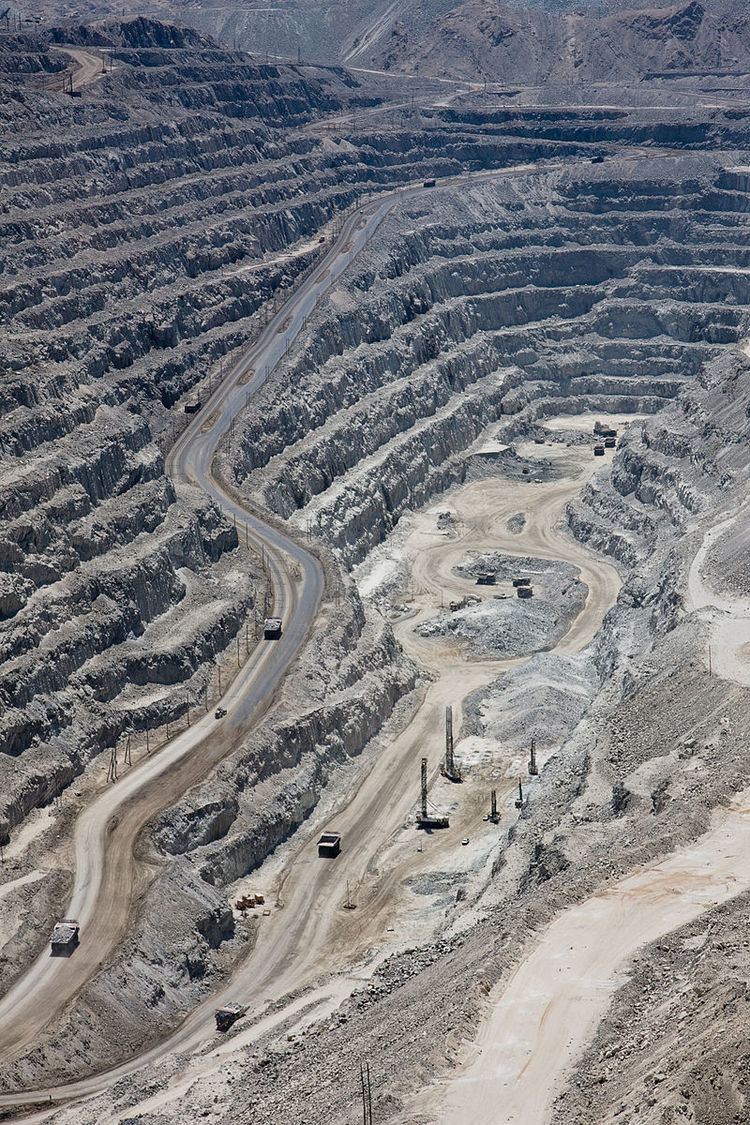 | ||
Uranium mining in Namibia is of considerable importance to the national economy. In 2011, Namibia was ranked as the 4th largest producer of uranium worldwide, behind Kazakhstan, Canada, and Australia. When Uranium prices fell after the Fukushima incident production was reduced. In 2012, Namibia produced 7.1% of Uranium oxide worldwide, trailing behind Niger as well.
Contents
- Background and history
- Rssing
- Langer Heinrich
- Husab
- Trekkopje
- Valencia
- Etango
- Others
- Environmental implications
- References
Uranium is one of the six mineral resources that were declared "strategic" by the Namibian government. Since the foundation of Epangelo Mining in 2009 no new exploration license may be granted without involvement by this governmental mining company.
Background and history
Uranium mineralization was first discovered in the Namibia's Rössing Mountains, Namib Desert in 1928 by Capt. G. Peter Louw. Though he tried promoting prospecting, it did not occur for another three decades. In the late 1950s, Anglo America Corporation of South Africa drilled and performed some underground exploration, but because of unstable uranium values and poor economic prospects, the search was abandoned. Uranium exploration was restarted in the country in the following decade, with Rio Tinto obtaining exploration rights for the Rössing deposit in 1966 and starting production in 1976.
The United Nations held special hearings on "The plunder of Namibian uranium" in 1980. Jacob et al. reported in the mid-1980s that the country's uranium mineralization was concentrated in the central zone of the Pan-African Damaran Orogen. In 1999, the International Atomic Energy Agency reported that the only operating mine in the county was the Rössing uranium mine, the largest uranium mine in the world. However, there has been a resurgence in the industry since 2003, and in 2008 uranium mine production in the whole of Africa increased by 16% compared to the previous year. Primary mines have since been opened, including Valencia, Ida Dome, and Goanikontes, as well as two secondary mines, Langer Heinrich (started in 2006) and Trekkopje (started in 2012).
Rössing
The Rössing mine contains the largest uranium deposit in the world associated with an igneous rock. Rössing Uranium is owned by Rio Tinto, the world’s largest mining group, which has annual profits of over $1.4 billion. It supplies enriched yellowcake uranium to power stations in France, UK, USA and Japan. The open-cast mine opened in 1976 and at one time faced closure. Rössing Uranium Ltd. processed about 12 million metric tons of ore in 2006 and produced 3,617 tons of uranium oxide (U3O8), and in 2009 they processed 12.6 million tonnes of uranium ore and produced 4150 tonnes of uranium orxide in comparison to 4067 tonnes in the previous year.
Langer Heinrich
When it opened in 2006, the Langer Heinrich mine was the first conventional uranium mine to be opened in the world in two decades. Langer Heinrich is now considered to have the greatest potential in the country, and saw a 59% increase to 1225 tons of uranium oxide in 2009, compared with 771 tons in 2008.
Husab
Swakop Uranium operate the Husab mine which is expected to be the second largest uranium mine in the world.
Trekkopje
The Paris-based multinational corporation Areva Group developed the Trekkopje Mine, but have decided to mothball the project. It is located 70 kilometres (43 mi) of Swakopmund. In 2009, operations were estimated to produce about 100,000 metric tons per day of ore and about 3,000 tons a year of yellowcake. The company has built a desalination plant which is expected to be operating until around 2024.
Valencia
Forsys Metals Corporation of Canada is developing the Valencia uranium deposit, which is located 40 km north of the Langer Heinrich mine. The company was granted a 25-year mining license in 2008 and, in 2009, announced the completion of an independent mineral resource study for Valencia. Measured and indicated resources were estimated to be 32,000 tones of U3O3- and 5,000 tons of U303+. It is expected to be producing from 2016 until about 2027.
Etango
Bannerman Resources Ltd. has an 80% interest in the Etango project, which is located southwest of Rossing Mine, about 41 kilometres (25 mi) east of Swakopmund. The Etango is considered to have the largest unexploited uranium resources in the world. The company is scheduled to start mining operations in 2013 and has predicted to produce between 2,300 and 3,200 per year of uranium oxide.
Others
Environmental implications
The environmental impact of uranium mining in Namibia has raised concerns amongst environmentalists, especially as many mining activities are conducted within the Namib-Naukluft National Park. The highly acidic tailings dams found at Namibia's uranium mines are an environmental concern. Monitoring activities include: air, water, and dust quality; biodiversity; medical surveillance; occupational hazards; and radiation protection.
